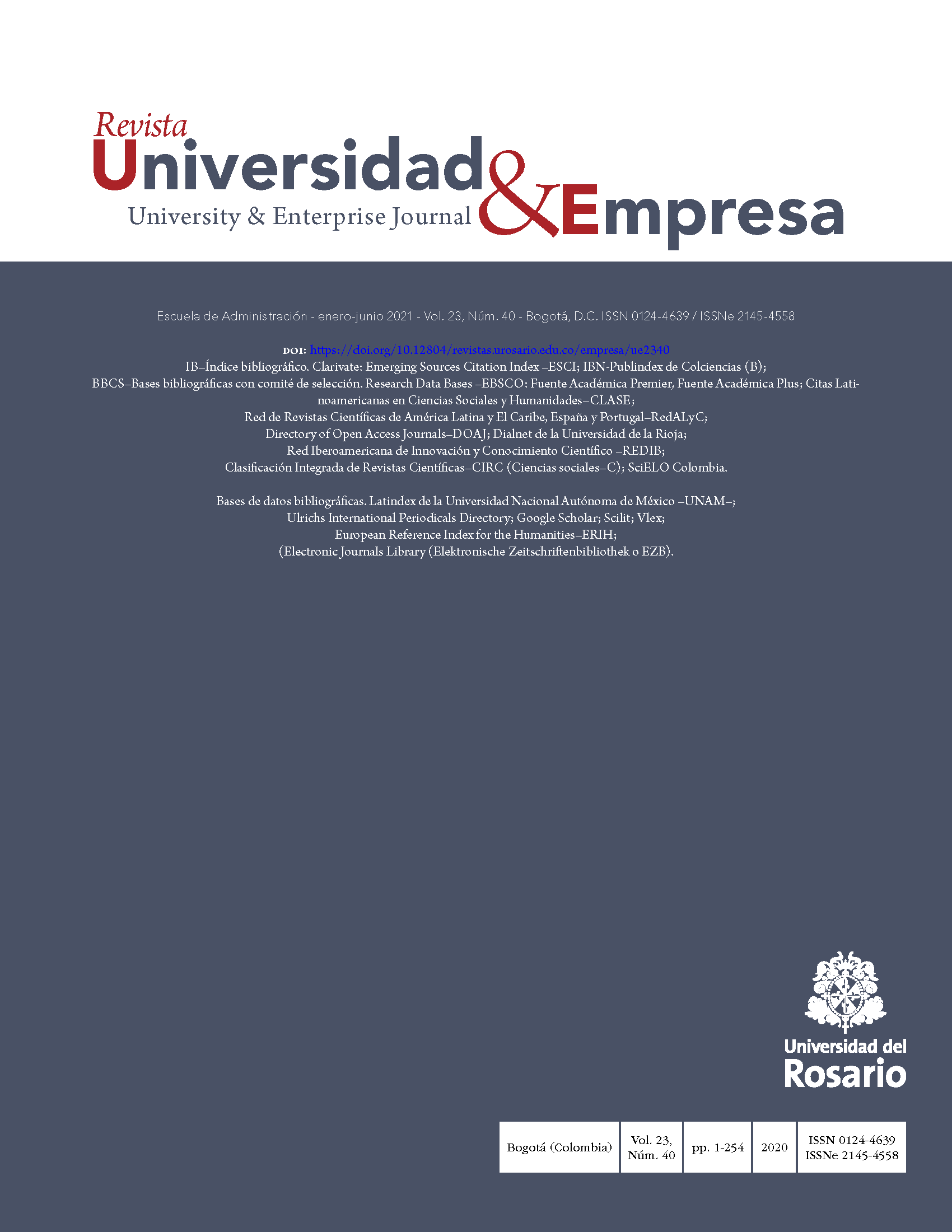Riesgo de insolvencia y devolución de acciones: análisis empírico de la puntuación Z de Altman en el sector minero peruano entre 2008 y 2018
Barra lateral del artículo
Contenido principal del artículo
Esta investigación pretendía evaluar la importancia del riesgo de insolvencia, referido por la puntuación Z de Altman, en la explicación del rendimiento histórico de las siete empresas mineras más líquidas que cotizan en la Bolsa de Valores de Lima (bvl) con base en un modelo de retorno de mercado bajo un enfoque transversal. En este sentido, se recolectaron datos diarios del índice s&p/bvl Peru Select y del Bono Soberano Peruano a diez años entre 2008 y 2018, aproximados trimestralmente por el promedio geométrico para homogeneizarlos con la frecuencia de Z. Así, se obtuvieron dos resultados centrales: (1) el Z-Score, como estimador de riesgo de insolvencia, que no es válido para explicar el comportamiento de la rentabilidad histórica de las acciones, y (2) la prima de mercado, que es estadísticamente significativa dentro del análisis de rentabilidad. Además, contrariamente a la literatura común, los resultados sugieren la validez del capm convencional de Sharpe.
Descargas
Edmundo R Lizarzaburu Bolaños, ESAN University
Edmundo R Lizarzaburu, Profesor de Finanzas y Riesgos en la Universidad ESAN, Consultor Internacional, Director de Empresas.Al-Kassar, T. A., & Soileau, J. S. (2014). Financial performance evaluation and bankruptcy prediction (failure)1. Arab Economic and Business Journal, 9(2), 147-155. 10.1016/j.aebj.2014.05.010 Retrieved from https://www.sciencedirect.com/science/article/pii/S2214462514000188
Altman, E. (1968). Financial ratios, discriminant analysis and the prediction of corporate bankruptcy. Journal of Finance, 23(4), 589-609. Retrieved from https://www.jstor.org/stable/2978933?seq=1#page_scan_tab_contents
Altman, E. (2000). Predicting Financial Distress of Companies: Revisiting the Z-Score and ZETA models. Stern School of Business, New York University. http://pages.stern.nyu.edu/~ealtman/Zscores.pdf
Altman, E., Hotchkiss, E. (2006). Corporate Finance Distress and Bankruptcy: Predict and Avoid Bankruptcy, Analyze and Invest in Distressed Debt. 3rd ed. New York: John Wiley & Sons. Retrieved from http://kadamaee.ir/payesh/books-tank/18/Altman%20&%20Hotchkiss%20%20Corporate%20Financial%20Distress%20and%20Bankruptcy,%203e%20(2006).pdf
Altman, E. I., Iwanicz-Drozdowska, M., Laitinen, E. K., & Suvas, A. (2017). Financial distress prediction in an international context: A review and empirical analysis of altman's Z-score model. Journal of International Financial Management & Accounting, 28(2), 131-171. doi:10.1111/jifm.12053
Ang, A., R. J. Hodrick, Y. Xing and X. Zhang (2006), ‘The Cross-section of Volatility and Expected Returns’, Journal of Finance, Vol. 61, pp. 259–99. Retrieved from https://doi.org/10.1111/j.1540-6261.2006.00836.x
Bannigidadmath, D., & Narayan, P. K. (2016). Stock return predictability and determinants of predictability and profits. Emerging Markets Review, 26, 153-173. doi:10.1016/j.ememar.2015.12.003
Behera, P. (2016). Bankruptcy prediction by using the altman Z-score model in oman. Australasian Accounting Business and Finance Journal, 10(4), 70-80. 10.14453/aabfj.v10i4.6 Retrieved from http://www.econis.eu/PPNSET?PPN=880383925
Brealey, R., Myers, S. & Allen, F. (2011). Principles of Corporate Finance. New York: McGraw-Hill/Irwin.
Bodie, Z., Kane, A. & Marcus, A. (2014). Investments. (10th. ed.) New York: McGraw-Hill Education.
Dalgin, M. H., Gupta, K., & Sraiheen, A. (2012). Testing CAPM for the istanbul stock exchange. International Journal of Economic Perspectives, 6(3), 224-234. Retrieved from https://search.ebscohost.com/login.aspx?direct=true&db=bth&AN=92026231&lang=es&site=ehost-live
Fama, E. F., & MacBeth, J. D. (1973). Risk, return, and equilibrium: Empirical tests. Journal of Political Economy, 81(3), 607-636. Retrieved from http://www.jstor.org.esan.idm.oclc.org/stable/1831028
Ferguson, A., Clinch, G., & Kean, S. (2011). Predicting the failure of developmental gold mining projects. Australian Accounting Review, 21(1), 44-53.
Fernández, P. (2019). WACC and CAPM according to Utilities Regulators: Confusions, Errors and Inconsistencies. Retrieved from https://ssrn.com/abstract=
Gao, P., Parsons, C. A., & Shen, J. (2018). Global relation between financial distress and equity returns. Review of Financial Studies, 31(1), 239-277. doi:10.1093/rfs/hhx060
Garlappi, L., & Yan, H. (2011). Financial distress and the cross-section of equity returns. The Journal of Finance, 66(3), 789-822. Retrieved from http://www.econis.eu/PPNSET?PPN=663881684
Gow, I. D., Ormazabal, G., & Taylor, D. J. (2010). Correcting for cross-sectional and time-series dependence in accounting research. The Accounting Review, 85(2), 483-512. Retrieved from http://www.econis.eu/PPNSET?PPN=627462499
Grice, J., Ingram, R. (2001). Tests of the Generalizability of Altman’s Bankruptcy Prediction Model. Journal of Business Research 54, 53-61. https://doi.org/10.1016/S0148-2963(00)00126-0
Habib, A., Bhuiyan, M. B. U., & Islam, A. (2013). Financial distress, earnings management and market pricing of accruals during the global financial crisis. Managerial Finance, 39(2), 155-180. Retrieved from http://www.econis.eu/PPNSET?PPN=742528693
Halteh, K., Kumar, K., & Gepp, A. (2018). Using Cutting-Edge Tree-Based Stochastic Models to Predict Credit Risk. Risks, 6(2), 55.
Hahn, J., & Yoon, H. (2016). Determinants of the cross-sectional stock returns in korea: Evaluating recent empirical evidence. Pacific-Basin Finance Journal, 38, 88-106. doi:10.1016/j.pacfin.2016.03.006
Harvey, C. R. and A. Siddique (2000), ‘Conditional Skewness in Asset Pricing Tests’, Journal of Finance, Vol. 55, pp. 1263–95. https://doi.org/10.1111/0022-1082.00247
Hayes, S., Hodge, K., & Hughes, L. (2010). A study of the efficacy of altman’s Z to predict bankruptcy of specialty retail firms doing business in contemporary times. Marquis Who's Who in America, Retrieved from http://search.credoreference.com/content/entry/marquisam/hayes_suzanne_k/0
Irina – Raluca Badea, & Gheorghe Matei. (2016). The Z-score model for predicting periods of financial instability. Z-score estimation for the banks listed on bucharest stock exchange. Finanţe: Provocările Viitorului, 1(18), 24-35. Retrieved from https://doaj.org/article/4b9d407517ec41aaad4f6af982d25148
Izan, H. Y. (1984). Corporate distress in Australia. Journal of Banking & Finance, 8(2), 303-320.
Jung, H., & Han, Y. (2017). Default Risk and Firm Value of Shipping & Logistics Firms in Korea. The Asian Journal of Shipping and Logistics, 33(2), 61-65. https://doi.org/10.1016/j.ajsl.2017.06.003. Retrieved from https://www.sciencedirect.com/science/article/pii/S2092521217300214
Karolyi, G. A., & Wu, Y. (2014). Size, value, and momentum in international stock returns: A new partial-segmentation approach. In Johnson Graduate School of Management, Cornell University Working Paper. Retrieved from http://w4.stern.nyu.edu/finance/docs/pdfs/Seminars/Karolyi_Wu_Size_Value_and_Momentum_in_International_Stock_Returns_01102014.pdf
Khan, K. I., Qadeer, F., & Ghafoor, M. M. (2017). Debt specialization within profitability sub-groups: A new perspective of debt structure choices. FWU Journal of Social Sciences, 11(2), 92-108. Retrieved from https://search.ebscohost.com/login.aspx?direct=true&db=asn&AN=127635305&lang=es&site=ehost-live
Kumari, N. (2013). Evaluation of financial health of MMTC of india: A Z-score model. European Journal of Accounting and Auditing & Financial Research, 1(1), 36-43. Retrieved from www.ea-journals.org
Legowik-Swiacik, S. (2017). The application of the altman Z-score in the assessment of the business model of the company. Research Papers of the Wroclaw University of Economics / Prace Naukowe Uniwersytetu Ekonomicznego we Wroclawiu, (474), 85-94. 10.15611/pn.2017.474.08 Retrieved from http://search.ebscohost.com/login.aspx?direct=true&db=bth&AN=125534105&lang=es&site=ehost-live
Lizarzaburu, E. (2014). Análisis del modelo Z de altman en el mercado peruano. Universidad y Empresa, 16(26), 141-158. 10.12804/rev.univ.empresa.26.2014.05 Retrieved from https://doaj.org/article/6b5e7048088342a78dc0f8292f59e348
Miralles-Quirós, M., Miralles-Quirós, J. L., & Goncalves, L. M. V. (2017). Testing the efficiency-CAPM joint hypothesis in the bovespa/Analise da hipotese conjunta da eficiencia do CAPM na BOVESPA/Analisis de la hipotesis conjunta eficiencia-CAPM em el BOVESPA. Revista De Gestao, Financas E Contabilidade, 7(3), 414.
Obrimah, O. A., Alabi, J., & Ugo-Harry, B. (2015). How relevant is the capital asset pricing model (CAPM) for tests of market efficiency on the nigerian stock exchange? African Development Review, 27(3), 262-273. doi:10.1111/1467-8268.12145
Ooghe, H., Balcaen, S. (2007). Are Failure Prediction Models Widely Usable? An Empirical Study Using a Belgian Dataset. Multinational Finance Journal 11, 33-76. Retrieved from https://ssrn.com/abstract=2623512
Opler, T., Titman, S. (1994). Financial Distress and Corporate Performance. Journal of Finance 49(3): 1015-1040. doi.org/10.1111/j.1540-6261.1994.tb00086.x
Polok, D., Michalski, P., Szewczyk, D., Keil, D., Wieczore, S., Kaciakova, P., Incze, Z., Rycerz, J., Nisztuk, T., Dvouletý, O. and Krzemiński, P. (2016). Future of the Visegrad Group. Retrieved from http://paga.org.pl/projekty/raport-future-of-the-visegrad-group/future-of-the-visegrad-group/report?lang=en
Purnanandam, A. (2007). Financial distress and corporate risk management: Theory and evidencedoi://doi.org/10.1016/j.jfineco.2007.04.003
Purnanandam, A., & Chava, S. (2010). Is default risk negatively related to stock returns? Review of Financial Studies, 23(6), 2523-2559. Retrieved from http://econpapers.repec.org/article/ouprfinst/v_3a23_3ay_3a2010_3ai_3a6_3ap_3a2523-2559.htm
Ríos, C. E. C., & Pérez, J. E. A. (2013). Análisis financiero integral de empresas colombianas 2009-2010: perspectivas de competitividad regional. Entramado, 9(1), 84-100.
Saden, N. S., & Prihatiningtias, Y. W. (2015). Financial distress prediction of mining companies listed in Indonesian Stock Exchange: An analysis using Altman Z-score model. Jurnal Ilmiah Mahasiswa FEB, 4(1).
Sharpe, W. F. (1964), ‘Capital Asset Prices: A Theory of Market Equilibrium under Conditions of Risk’, Journal of Finance, Vol. 19, pp. 425–42. https://www.jstor.org/stable/2977928?seq=1#page_scan_tab_contents
Smith, M., Liou, D. (2007). Industrial Sector and Financial Distress. Managerial Auditing Journal 22, 376-391. Retrieved from https://www.emeraldinsight.com/doi/pdfplus/10.1108/02686900710741937
Steinker, S., Pesch, M., & Hoberg, K. (2016). Inventory management under financial distress: An empirical analysis.International Journal of Production Research, 54(17), 5182-5207. doi:10.1080/00207543.2016.1157273
Szymanska, E. J. (2017). Determinants of profitability of enterprises of meat industry in poland. Acta Scientiarum Polonorum. Oeconomia, 16(3), 83-91. 10.22630/ASPE.2017.16.3.36 Retrieved from https://search.ebscohost.com/login.aspx?direct=true&db=bsu&AN=126176216&lang=es&site=ehost-live
Xu, M., Zhang, C. (2009). Bankruptcy Prediction: The Case of Japanese Listed Companies and Application in Credit Rating for Listing Firms in China. Review of Accounting Studies 14, 534-558. https://doi.org/10.1007/s11142-008-9080-5
Detalles del artículo

Esta obra está bajo una licencia internacional Creative Commons Atribución-NoComercial-SinDerivadas 4.0.
Los autores conservan los derechos de autor y garantizan a la revista el derecho de ser la primera publicación del trabajo al igual que licenciado bajo una Creative Commons Attribution License que permite a otros compartir el trabajo con un reconocimiento de la autoría del trabajo y la publicación inicial en esta revista.Artículos más leídos del mismo autor/a
- Edmundo R Lizarzaburu Bolaños, Gabriela Barriga, Eduardo Noriega, Gestión Integral de Riesgos y Antisoborno: Un enfoque operacional desde la perspectiva ISO 31000 e ISO 37001 , Revista Universidad y Empresa: Vol. 21 Núm. 36 (2019)



